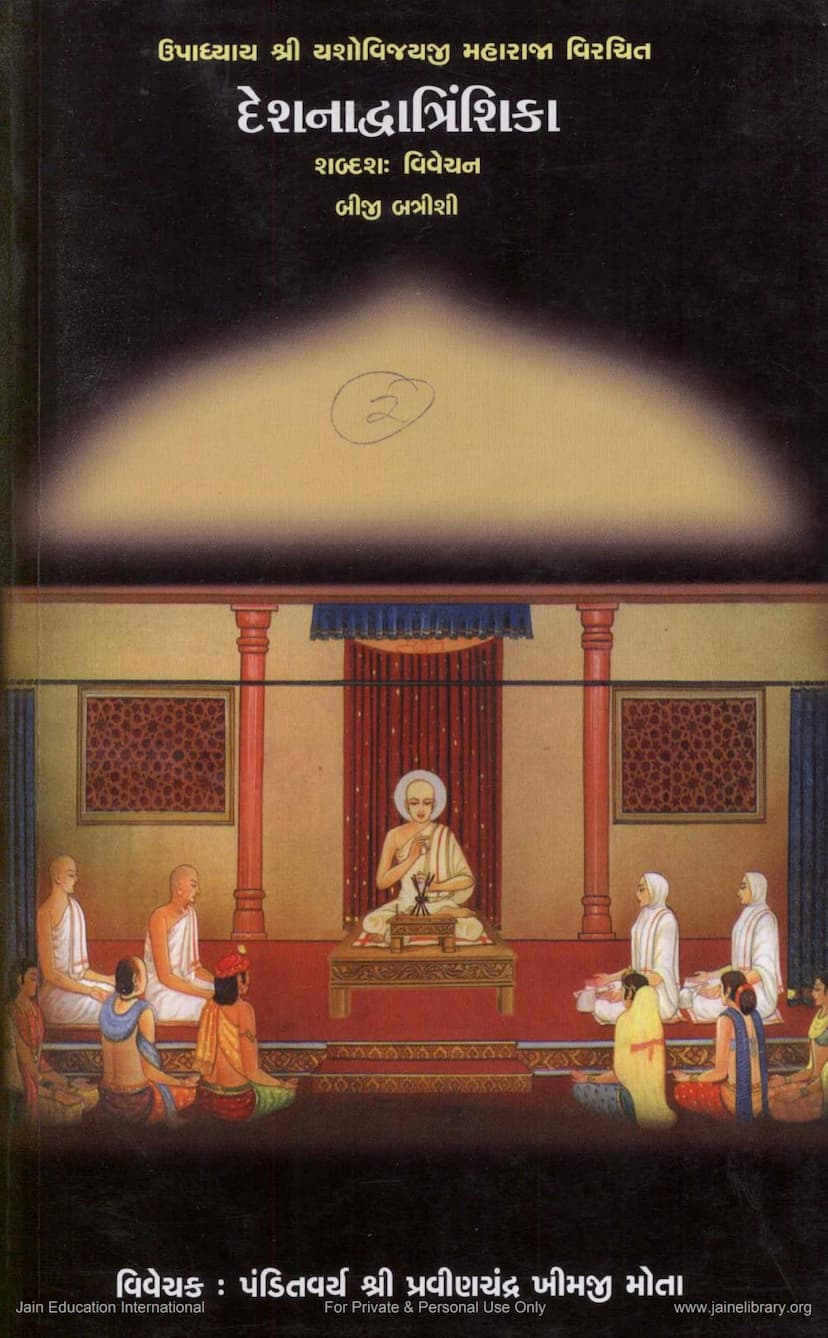Deshna Dvantrinshika
Added to library: September 1, 2025

Summary
Here's a comprehensive summary of the provided Jain text, "Deshna Dwatrinsika," based on the given pages:
Book Title: Deshna Dwatrinsika (દેશના દ્વાત્રિંશિકા) Author: Mahamahopadhyaya Shrimad Yashovijayji Maharaj (મહામહોપાધ્યાય શ્રીમદ્ યશોવિજયજી મહારાજા) Commentary/Critique Author: Pandit Shrimad Pravinchandra Khimji Mota (પંડિતવર્ય શ્રી પ્રવીણચંદ્ર ખીમજી મોતા) Publisher: Gitarth Ganga (ગીતાર્થ ગંગા)
Overall Purpose and Context:
This text is a commentary ("Vivechan" - વિવેચન) on the "Deshna Dwatrinsika," which is a section of a larger work by the renowned Jain scholar Mahamahopadhyaya Yashovijayji Maharaj titled "Dwatrinsadwatrinsika" (દ્વાત્રિંશદ્વાત્રિંશિકા). The "Dwatrinsadwatrinsika" itself is a significant work where Yashovijayji Maharaj elaborates on thirty-two different topics with thirty-two profound verses each, accompanied by his own commentary. "Deshna Dwatrinsika" specifically focuses on the principles and art of religious discourse (Deshna - દેશના).
The commentary by Pandit Pravinchandra Mota aims to explain Yashovijayji's original verses in detail, word by word, making the profound philosophical concepts accessible to a wider audience. The Gitarth Ganga Trust publishes this work as part of its mission to analyze and disseminate the teachings of earlier Jain Acharyas, making them beneficial for the Jain community.
Key Themes and Content of Deshna Dwatrinsika (as explained by the commentary):
The core of "Deshna Dwatrinsika" is dedicated to outlining the principles of effective and beneficial religious preaching or teaching. It emphasizes that a true preacher (Upadeshak - ઉપદેશક) must consider the audience and tailor their discourse accordingly.
1. The Importance of Audience Awareness:
- Three Types of Listeners: The text categorizes listeners into three types: Bal (બાલ - immature/beginner), Madhyam (મધ્યમ - intermediate), and Pandit (પંડિત - learned/advanced).
- Tailored Discourse: Just as a skilled physician prescribes medicine suitable for the patient's condition, a preacher must deliver a discourse that aligns with the listener's level of understanding and spiritual maturity. This is crucial for promoting their spiritual growth and alleviating their suffering.
- Consequences of Improper Discourse: Delivering a discourse without considering the audience can lead to negative consequences for both the listener and the preacher. It can cause karmic bondage for the preacher and may not benefit the listener.
2. The Nature of Bal, Madhyam, and Pandit Listeners:
- Bal (Immature): These individuals are primarily focused on external practices (Bahya Achar - બાહ્ય આચાર) and outward rituals or appearances (Ling - લિંગ). They may not grasp the deeper philosophical implications. The commentary explains that while their focus is on externals, a wise preacher can guide them towards more meaningful practice by emphasizing the virtuous aspects of these external actions with a touch of discretion.
- Madhyam (Intermediate): These listeners are concerned with subtle practices (Sukshma Yatana - સૂક્ષ્મ યતના) and the outward adherence to rules. They may also be driven by a desire for recognition. The commentary suggests that their practices, while better than purely external ones, can still be flawed if not guided by deeper understanding and a detachment from ego.
- Pandit (Learned): These are individuals who strive to understand the true essence of scriptures (Shastra Tatva - શાસ્ત્ર તત્ત્વ) through all their efforts. They are intellectually inclined and capable of deeper analysis.
3. The Path to True Understanding (Jnana - જ્ઞાન): The text outlines a three-stage process for a learned individual (Pandit/Budh - પંડિત/બુધ) to attain true scriptural understanding:
- Shruta Jnana (શ્રુતજ્ઞાન): This is the initial stage of understanding derived from scriptures. It is based on universally accepted principles (Sarvanug Vakya - સર્વાનુગ વાક્ય) that are not contradictory to established logic or scriptural norms (Praman-Naya Varjita - પ્રમાણ-નય-વર્જિત). It's like preserved seed, holding the potential for future growth.
- Chinta Jnana (ચિન્તાજ્ઞાન): This stage involves intellectual contemplation and reasoning, analyzing the meaning of scriptures with the help of logic (Yukti - યુક્તિ) and the principles of Syadvada (સ્યાદ્વાદ - the Jain doctrine of manifold predicaments). It's like a drop of oil spreading in water, expanding understanding.
- Bhavana Jnana (ભાવનાજ્ઞાન): This is the highest stage, where the understanding gained through Shruta and Chinta Jnana is internalized and consistently contemplated. This leads to a deep realization and alignment of one's actions with the divine commandments (Agya - આજ્ઞા). This stage is described as the most beneficial, like a life-saving elixir (Sanjivini - સંજીવની).
4. The Nature of True Spiritual Practice: The commentary highlights that mere external practices (Bal) or even subtle practices without deep understanding (Madhyam) are insufficient. True spiritual progress comes from understanding the essence (Tatva - તત્ત્વ) through the stages of knowledge, culminating in Bhavana Jnana. This is crucial for achieving detachment (Asanga - અસંગ) and ultimately, liberation.
5. The Preacher's Role and Responsibility:
- Avoiding Misdirection: Preachers who do not understand the audience or the nuances of scripture can inadvertently mislead listeners. This is likened to a poisonous snake's venom, which is far more destructive than the venom of a viper.
- The Power of Bhavana Jnana: The ultimate goal is to cultivate Bhavana Jnana in oneself and to guide others towards it. This stage enables the practitioner to understand the true intent (Tatparya - તાત્પર્ય) of scriptures and act accordingly, leading to true welfare.
- Respect for Preachers: The text concludes by expressing profound reverence for those who are accomplished in scriptural understanding and capable of delivering discourses that nurture Dharma (Saddharma Deshak Geetarth Muni - સદ્ધર્મદેશક ગીતાર્થ મુનિ), especially in the current degenerate age (Kalikal - કલિકાળ). Their influence ensures the continued growth of Dharma.
Commentary's Contribution:
Pandit Pravinchandra Mota's commentary provides a detailed breakdown of Yashovijayji's verses, explaining their literal meaning, philosophical implications, and the context within Jain philosophy. It clarifies complex terms, offers analogies, and addresses potential doubts or counter-arguments, making the profound teachings of Yashovijayji accessible and practical for contemporary readers.
In essence, "Deshna Dwatrinsika," as interpreted by this commentary, is a foundational text for anyone involved in teaching or learning about Jainism, offering a sophisticated framework for spiritual discourse that prioritizes intellectual understanding, ethical conduct, and the ultimate realization of the self.